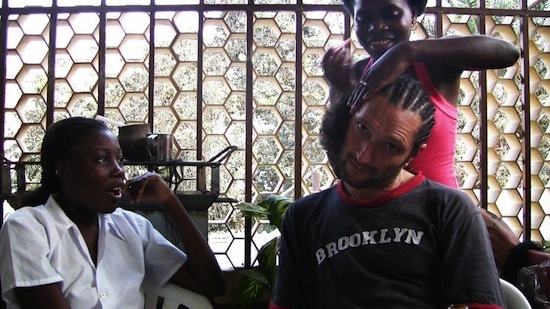I've been a huge admirer of Jeremy Xido's work since watching his spellbinding documentary Death Metal Angola at the Dubai International Film Festival in 2012. His work is heartfelt and true, possessing both admiration for his subjects and an essential, intrinsic quality to transmit empathy to his audiences. What Xido does through his work, and with his wonderfully inspiring personality, is make you feel like you are part of his project because, once and for all, you understand what it means to be an engaged human being.
Perhaps though what was missing for most audiences watching Death Metal Angola, was a way to get to know Xido himself, because he happens to be such an interconnected part of his work. I got to interview him in Dubai, spent time with him at the various events around the festival, and I felt that luxury should be spread to more people. Luckily, starting this week, it will be.
Kicking off on January 14th in Brooklyn, co-presented by P.S. 122 and The Invisible Dog Art Center, then moving on to Chicago Jeremy Xido will be performing The Angola Project, a multi-art piece in three parts that gets to the heart of the matter, quite literally. But also manages to explain and deconstruct the traveler that is within all of us, while at the same time deglamorizing the business of cinema. I think tying all those themes together would probably prove impossible for nearly everyone, but Xido does it with courage, humility, insight, and manages to infuse the whole thing with great entertainment. Think of it as the perfect cross between a travelogue, a personal diary, part TED Talks and the best film you've watched this year. There'll be secrets revealed, loves lost and distant lands explored, and all experienced from the comfort of your theater armchair.
I asked Xido to speak a bit about The Angola Project, which he co-created with Claudia Heu and Igor Dobricic for CABULA6, and explain how this fascinating idea came about.
The Angola Project was born before your film Death Metal Angola was made, so how did it change after getting your film out there?
Jeremy Xido: The biggest change is that there is now a third part. When we set out, we had no idea that there would be a part 3 -- but once you have part 1 and part 2, it's very hard to resist imagining a part 3. And in many ways, part 3 takes the obsessive story-telling quality of the first two parts to its logical conclusion -- exhaustion. So part 3 really reframes the entire piece because only retrospectively is the heart of the entire trilogy revealed as an exhaustive attempt to strip me of all of my various stories until I can simply be present with an audience in the here and now. Which is the truth of what is always going on in a theater. Basically a bunch of people are all sitting in a room together at a moment in time.
What was your initial inspiration for this project and how did you and your co-creators come about creating a one-man performance art show?
Xido: Five years ago I was invited to Lisbon, Portugal by an arts organization called Transforma to create a new performance piece dealing in some way with immigration. At that point in my life, all I really wanted to do was make a narrative feature film. I had been making stage work for a number of years and was sort of fed up with it, but it was what I was known for, so we struck a deal: I would research a screenplay and whatever materials I collected would be used as the basis for a "lecture performance." The idea was to go onstage with a bunch of interviews, film clips, half baked ideas, stories I had heard, conflicting histories, horticultural facts and pure hearsay and attempt to cajole it all into a Hollywood screenplay.
I became fascinated by the way that moments in the story I was creating would sort of half form and then crumble away, revealing a complexity beneath the story, that a single tale couldn't contain. But however fascinating, I still didn't want to make a performance. All I wanted to do was make a feature film. And the research for this film took me from Lisbon to Angola and then back to Europe when my narrative feature idea turned into the idea for a documentary about Chinese construction workers rebuilding the Benguela Railway.
In a way, this was perhaps really the beginning of The Angola Project. The moment I had the idea for a documentary, I was sucked into the world of European documentary film financing and was thrown headfirst into the into the art of "pitching" -- the promise to turn lived experience in the "real world" into a commodity whose value would be determined in a cultural marketplace which has little to no context for understanding that world.
It was at this point that Igor Dobricic, Claudia Heu and I started think more deeply about The Angola Project as a performance piece in which my personal travels and stories and real-life attempt to make an actual movie provided a frame around which all the disparate experiences I was having could coalesce and be shared. It is an old classical form -- the traveler tells his or her story.
To someone who has watched your film, Death Metal Angola, how much of that is in this performance?
Xido: The Angola Project is sort of like the poor cousin to Death Metal Angola. They were both accidents. I originally set out to make a film about Chinese construction workers rebuilding the Benguela Railway in Angola. And for all kinds of reasons this project was thwarted over and over again. But these obstructions ended up opening doors I never realized were there. Behind door number 1 was Death Metal Angola and behind door number 2 was The Angola Project.
They are made of the same DNA. Death Metal Angola is entirely indebted to my experiences of growing up in Detroit and watching the worlds around me crumble and decay as people fought to survive and make sense of their world. And The Angola Project begins with my personal story and a trip I set out on and careens through history, revealing unanticipated and forgotten connections linking me in Detroit to Angola 500 years ago.
I read it's a kind of ode to Travelogues of the 19th century?
Xido: I'm not sure that I see it as so much an ode as a confrontation. It was a shock to realize that what I was doing -- this travel lecture performance -- actually has an historical precedence in those Travelogues. And those Travelogues were themselves the progenitors of documentary film. Again, more of an entanglement than anything else.
Can you go through each part of this three-part performance?
Xido: The three parts follow my life chronologically over the 5 years I attempted to make this feature documentary about Chinese construction workers in Angola. And, as sometimes happens in life, we're dealt unexpected blows. Shortly after premiering parts 1 and 2 in Vienna, I experienced both some serious medical problems followed by a series of heartbreaks, and I was simply unable to continue working on The Angola Project in the way that we had been working on it. My life sort of fell apart and I was directly confronted with mortality. There was a rupture in the fabric of the universe for me. And in the face of that, telling stories seemed irrelevant. But there I was creating the third part of the piece that was entirely about storytelling. Part 3 didn't become so much a meditation on death, but a question of what happens after you've died.
What are the future plans for The Angola Project?
Xido: My dream is to tour the trilogy through the United States following the old travel lecture circuit, performing in a mixture of theaters, art museums, churches, bingo halls and empty fields throughout the South and Midwest. Alternating the audiences I come in contact with -- from people who regularly visit high-cultural institutions to those who have never stepped foot in a theater. The core themes of the piece have to do with identity, history, class and race. My dream is to actually have these conversations. For real.
And what do you hope to inspire in your audiences?
Xido: A vision that the world is vastly more complex, varied and unexpected than pretty much anything we imagine or have been told. And that it belongs to each of us. We have a right to be here, simply because we are here. I want the piece to help us see one another and not be afraid of who we are.
A more personal question, what do you feel when you perform such a piece, alone, on stage?
Xido: I feel at home.

